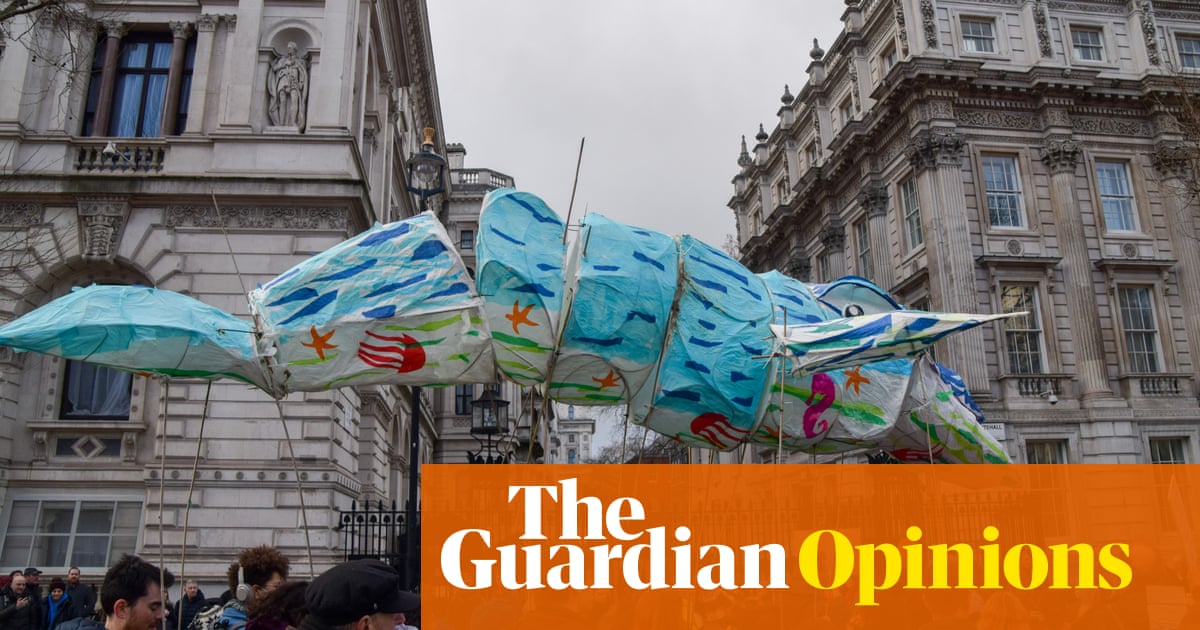
Channeling the spirit of legendary former US President Franklin Roosevelt, UK Prime Minister Boris Johnson outlined on Tuesday what he called a “New Deal” for the country’s post-pandemic recovery.
Yet his vision was little more than a recycling of old announcements, in what is a pale imitation of Roosevelt’s historic program of public spending after the Great Depression.
During Johnson’s big speech, which was headlined “build, build, build,” he announced the acceleration of a number of previously pledged projects as part of a £5 billion ($6.2 billion) investment plan. This includes: £1.5 billion for building and maintaining hospitals; more than £1 billion to fund a schools-building project; £900 million for “shovel-ready” local infrastructure projects; £100 million for 29 road-network projects; £83 million for the maintenance of prisons and youth-offender facilities; and a new towns fund for improvements to parks, high streets and transport.
Welcome as these measures are, Johnson’s speech was hastily cobbled together and a far cry from the soaring prose of many of Roosevelt’s addresses. The prime minister likes big, historical comparisons, and is a keen student of Winston Churchill, but the comparisons between what he re-announced and the New Deal are fanciful.
For starters, the scale of the spending Johnson re-announced (which is the equivalent of about £100 per person in the UK) is puny compared to the scale of Roosevelt’s New Deal. As a result, Johnson runs the risk of raising public expectations to a level he cannot hope to meet.
In part, this is because the New Deal ran for several years, with annual spending between about 5 percent and 7 percent of the total output of the economy, and US federal-government debt growing from 16 percent of GDP in 1929 to 44 percent in 1939. In comparison, Johnson’s £5 billion plan represents less than one quarter of 1 percent of GDP.
The measures he announced are, therefore, far from what is likely to be required, in terms of economic stimulus, to bolster the UK economy in the second half of this year and into 2021. On Tuesday, Bank of England Chief Economist Andy Haldane gave a separate speech, at much the same time as Johnson was giving his, highlighting the fact that perhaps as much as half of the UK workforce is currently unemployed or underemployed, a situation he said is without historical precedent.
This is because about 9 million workers are furloughed, with their salaries being paid by the government, 2.5 million self-employed people are receiving separate public-funding support, and eight million employees are working fewer hours than usual.
The prime minister is aware of the mismatch between his rhetoric and the reality of the situation, but delivered his speech anyway, given the further bad economic news looming on the horizon, his slumping poll ratings, and what he sees as the political imperative to try to move the country beyond the coronavirus outbreak.
This is despite the fact that, as he acknowledged in Tuesday’s speech, the pandemic “continues to circle like a shark.” A day earlier, in fact, the government announced the country’s first localized lockdown, in Leicester, a city in the English Midlands with a population of about 300,000.
The political reasoning behind Johnson’s speech is intensified by his desire to double down on his general election victory in December, for which the Conservatives redrew, at least temporarily, the political map of the United Kingdom. As a result, Johnson won a number of long-standing Labour strongholds, especially in the Midlands and North of England. It was no coincidence that he gave Tuesday’s speech in Dudley, which is one of those constituencies.
Johnson, who is already looking ahead to the next general election, probably in 2024, believes the key to retaining many of these former Labour (so-called “red-wall”) seats is two-fold. Firstly, the government must deliver on what it calls the “leveling-up” agenda, including new spending on infrastructure, to reduce socioeconomic inequalities across the nation.
Expect this theme to be echoed, therefore, in a speech by Chancellor Rishi Sunak next week, and also reflected in the next round of the Government’s Comprehensive Spending Review, which will set levels of public spending for at least three years, and the chancellor’s autumn budget in November.
The second piece in this political jigsaw puzzle for Johnson is the fact that the UK must complete the transitional period of its departure from the EU by December, so that he is perceived to be delivering on his 2019 pledge to “get Brexit done.”
So totemic is this issue for the prime minister that he is now, unquestionably, willing to complete the transition by the end of the year, even if no trade deal has been agreed with Brussels and the remaining 27 EU members, regardless of the further economic damage this could cause.
The scale of the spending Johnson re-announced is puny compared to the scale of Roosevelt’s New Deal.
Andrew Hammond
While at least an interim UK-EU deal (or, potentially, a set of sector-relevant deals) might remain possible this year, there is a significant chance of the talks collapsing. While Johnson seems relaxed about this prospect, it could have a devastating economic impact on the disadvantaged UK communities where his leveling-up agenda is most important.
The prime minister might now, therefore, find himself boxed into a situation whereby delivering on Brexit, come what may, undermines his aspirations to boost prosperity in the least-prosperous parts of the nation.
Far from doubling down on the leveling-up agenda, this could lead to the biggest spike in inequality since the 1980s, undermining not only the nation’s social fabric, but also Johnson’s chances of a second term in office.
Andrew Hammond is an Associate at LSE IDEAS at the London School of Economics
Disclaimer: Views expressed by writers in this section are their own and do not necessarily reflect Arab News" point-of-view












